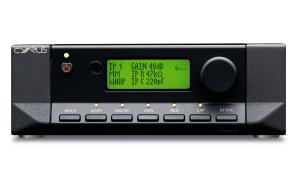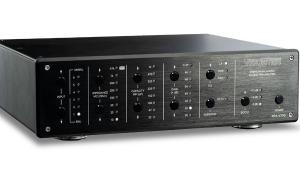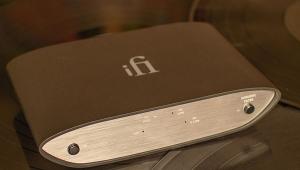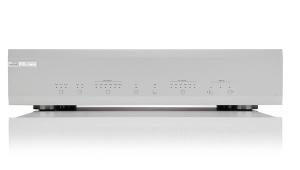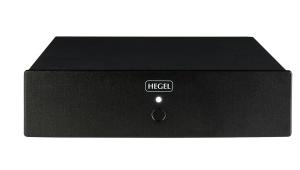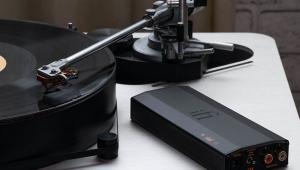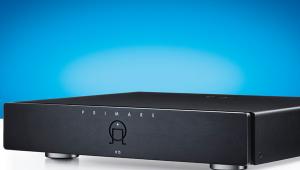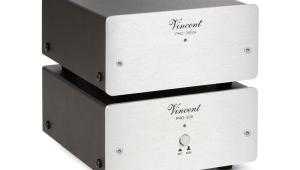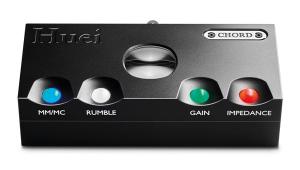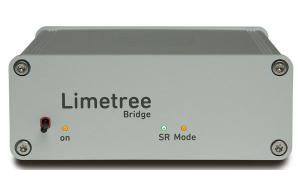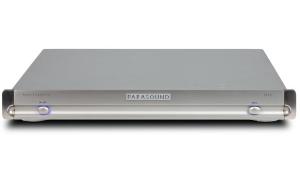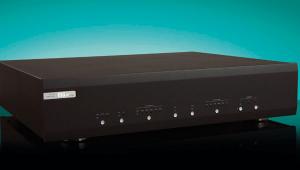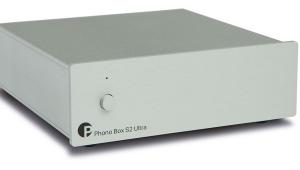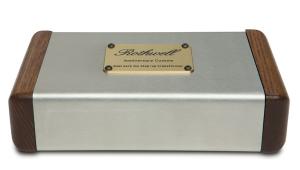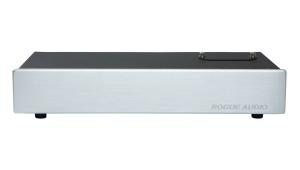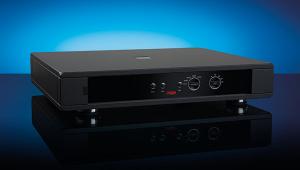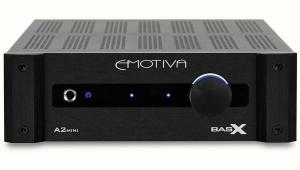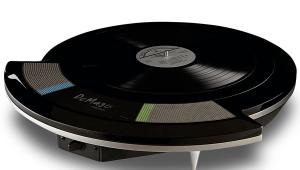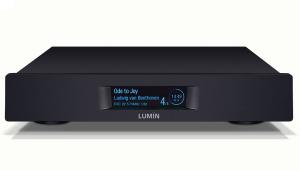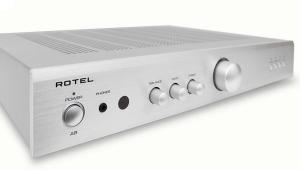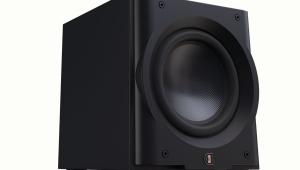Icon Audio PS3 MkII - £2,499
![]()
Getting a valve phono stage to work well is no easy task when you bear in mind that on the quieter parts of a record, the output from a moving coil cartridge may only be about a millionth of a volt. This needs to be amplified up to a standard line-level output of around 1.2Vrms, so for a start the whole circuit and power supply needs to be as quiet as a mouse. Then the stage itself also has to be first rate and stable under all operating conditions. As a result, designing a high-end model can be quite an undertaking, but Icon Audio has met this challenge head on with the PS3 MKII.
The first thing to get right is the power supply. In order to achieve maximum isolation of the mains components (including the mains transformer), the PSU is housed in a separate enclosure. It is an all-valve design using an oversized power transformer and a full wave valve EZ80 rectifier. The output from this feeds into a hefty smoothing circuit to eliminate all traces of hum from the supply. This circuit employs two weighty chokes (effectively half of a transformer), which is the best way to do this. Just having a very clean DC supply is not good enough for the demands of a phono stage – it also has to be very accurately controlled. This is achieved by no less than three more glass bottles, namely an EL84 pentode, an ECC83 double-triode and a cold-cathode OA2 voltage reference valve.
The phono stage itself uses four ECC88 double-triode valves in a very elegant circuit, called a double cascode amplifier, to provide the high gain and low-noise performance required for excellent detail and sound staging. This circuit offers a very wide bandwidth without the need for any feedback, which reduces distortion. Also included at this point is a very high quality passive RIAA equalisation circuit.
Finally, the output is buffered with a lovely 6SN7 double-triode to provide a low (50ohm) output impedance, so the phono stage will be able to feed virtually any preamp. Incidentally, the 6SN7 was introduced in 1941 and is still considered by many to be one of the best sounding audio valves ever.
Although the phono stage is only required to produce a volt or so of output, its design could actually generate voltages of up to 40V before clipping, so it has a massive headroom and will certainly never bat an eyelid at the loudest of organ stops – or heavy metal for that matter! The MC input uses Icon Audio’s own hand-wound moving coil toroidal transformers. Icon considers that transformers offer superior performance over a transistor circuit for providing the extra x10 amplification and impedance matching that’s required.
The phono stage is all hand wired point-to-point, meaning that no printed circuit boards are used. This means that components can be easily changed or upgraded if you wish. Many audiophile components have been used in the circuit, such as silver wire in a PTFE dielectric audio cable, as well as gold-plated input and output connectors. The Signature version reviewed here uses Jensen paper-in-oil capacitors and special valves, but the standard version still uses Solen/SCR polypropylene audio-grade capacitors. As a result, the standard MM-only version costs £1,899 while the MM and MC version will set you back £2,099.
Both boxes are beautifully finished in a matt-black metal enclosure topped with a gorgeous copper-coloured metal plate. The transformers are enclosed in a matching black metal screen. The amplifier front panel has the MM/MC selector that switches between two sets of inputs so two turntables can be supported, one with a MM cartridge and the other with either a MM or MC cartridge. There is also an Alps Blue volume control and a stereo/mono switch. The switch is an excellent inclusion as it will reduce noise levels when listening to mono recordings.
Sound quality
While allowing the PS3 Signature to warm up for my listening session, I select some material from my LP collection. The first thing to say is that, as expected with all the supply smoothing, there is no trace of hum (or hiss for that matter) even when I put my ear up close to my loudspeakers. I set the volume control on the PS3 to its maximum level, so it is effectively out of circuit and I am now ready to listen to the first LP – a superb recording of Prokofiev’s Piano Concerto No. 2 played by Vladimir Ashkenazy and the London Symphony Orchestra. I am instantly struck by the enormous soundstage – the PS3 has turned my sitting room into a TARDIS! Both the side-to-side and the front-to-back imaging far exceeds what I have been used to with this recording. Having said that, all the instruments are well focused and there is no tendency to blur their position. The piano sounds full and rich with splendid detail and realism.
Next onto the turntable is a copy of JS Bach’s Partita No. 1 by Trevor Pinnock. The solo harpsichord again displays a lot of detail and clarity and I have a real sense of being totally involved with the performance. In other words, I feel as though Trevor is playing this in my sitting room especially for me!
I then turn to another recording of a full orchestra – Haydn’s Symphony No. 35 by L’Estro Armonico & Derek Solomons. This performance gives a full sound with instrumentation that is rich and multi-dimensional. The soundstage in no way seems restricted to the area between the loudspeakers. There is a huge amount of detail in the upper registers and the exciting content of the music is really well conveyed to the listener.
Ramping up the tempo with Jean Michel Jarre’s Equinoxe demonstrates a good dynamic range with a crisp top end and meaty bass. The PS3 MKII Signature simply doesn’t seem to hold anything back from the recording, letting rip with a fast and detailed performance that is enormously engaging.
For vocals, I decide to give Don’t Misunderstand by Thelma Houston a spin. This recording demonstrates the perfectly proportioned front-to-back positioning of the singer out in front with the instruments playing behind. Again, the sheer energy and enthusiasm of the performance is splendidly conveyed to the listener, and the performance is captivating.
Finishing off with some baroque music, a fantastic recording of Vivaldi’s Opus 3 concertos, L’Estro Armonico performed by The Academy of Saint Martin-in-the-Fields directed by Neville Marriner is both compelling and enchanting. I recently attended a concert at Saint Martin-in-the-Fields and noted that you can occasionally hear the traffic outside during a concert. This accounts for the occasional rumble of a lorry driving past in the background on the recording, which is reproduced with spectacular clarity!
Conclusion
In the interests of balance, I have to admit that I’m not a big fan of potentiometers as volume controls on high-end equipment and would much prefer to see a stepped attenuator fitted in its place, as a potentiometer can often be a potential source for introducing noise and distortion into the signal path. Given that this phono stage is likely to be used in conjunction with a preamplifier, I think it is unnecessary to have a volume control anyway, except perhaps to pre-set the output to a level that is comparable with other sources in your system. For this purpose, a simple coarse stepped attenuator with just a few steps will be more than adequate for the job. Of course, one could easily be fitted if required. Also, Icon Audio is happy to replace the volume control with a pair of fixed resistors fitted internally, and this service is offered free of charge.
Having said that, the PS3 MKII Signature is a very impressive-sounding phono stage. I hesitate to over do the superlatives, but the build quality is really superb and the sound quality is about as good as it gets. I genuinely can’t fault it sonically. Oh and it looks fantastic too, and its appearance surely merits pride of place on any hi-fi rack.
LIKE: Superb sound quality
DISLIKE: Would have preferred a stepped attenuator instead of a potentiometer for the volume control
WE SAY: One of the finest sounding phono stages available
DETAILS
PRODUCT Icon Audio PS3 MKII Signature
ORIGIN UK
TYPE MM and MC phono stage
WEIGHT Phono stage: 4kg Power supply: 7kg
DIMENSIONS (WxHxD) 148 x 165 x 342mm
FEATURES
• Built-in volume control
• Stereo/mono switch
• Valve rectified and regulated power supply
• Passive RIAA stage in a zero-feedback design
DISTRIBUTOR Icon Audio
TELEPHONE 0116 2440593
WEBSITE iconaudio.com
 |
Inside this month's issue:
Ruark R610 music system and Sabre-R standmount speakers, PMC twenty.23i Active, floorstanders, English Acoustics Downton preamplifier, Bluesound NODE ICON preamp/streamer, Ortofon Concorde Music Blue MM cartridge and much, much more
|
